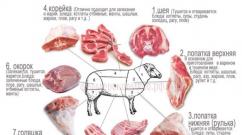Types of battle axes. The battle ax is the deadly weapon of real warriors

Good day everyone! By writing this article, I am opening a new section on my resource - chopping bladed weapons. There are many types of battle axes and it is simply impossible to consider them all in one article. And therefore, this article will be introductory - a kind of introduction to all subsequent ones, and at the same time - a table of contents for the section. I have already used this practice earlier in the section on “ daggers».
Now let's get straight to the point. We all imagine the appearance of an axe, and this is not surprising - an ax is such a useful, convenient and practical thing for creative work, known to everyone, that it is simply impossible not to know about it. We will touch on a more interesting component of the axe’s incarnation – its combat use and varieties.
A multifunctional striking-cutting edged weapon, a type of ax designed to defeat enemy personnel. A distinctive feature of the battle ax is the light weight of the blade (about half a kilogram) and the long ax handle (from fifty centimeters). Battle axes were one-handed and two-handed, one-sided and two-sided. The battle ax was used both for close combat and for throwing.
According to the generally accepted classification, the ax occupies an intermediate place between conventional striking weapons and bladed melee weapons. This is a group of cutting bladed weapons or, as it is also called - slashing bladed weapon.
A little about the origin of the ax...
First, let's define when does the history of the ax begin? An ax similar to the classical form, having a handle and a striking part, appeared approximately six thousand years BC, during the Mesolithic era. The ax was used mainly as a tool and was intended for cutting down trees, building houses, rafts and other things. The striking part was stone and roughly hewn. It was only in the later stages of the Stone Age that the ax began to take on a more “human” appearance. Ground and drilled stone axes began to appear, which were no longer used only as entrenching tools, but also as weapons in close combat or hunting.
An ax, in general, is the clearest example of how an economic tool can be reborn and become a bladed weapon. This mainly explains its widespread distribution among almost all peoples. And before the advent of other purely combat weapons, such as the sword, the ax was a kind of monopolist in the field of effective edged weapons. After the appearance of the sword, they became the main rivals for primacy in the field of combat edged weapons, this is especially clearly seen in the example of the West.
Why did the ax never lose the fight with the sword?
The answer to this question lies on the surface. True, there are quite a few reasons. Let's look at them. I will not consider the positive qualities of the sword, since the article is still about axes.
So, here we go:
- The ax is much easier to make.
- The ax is more versatile.
- At close and short distances, the ax can be used as a throwing weapon.
- Significantly greater impact force due to the large mass and short blade.
- Almost the entire design of the ax works in combat. The corners of the blade can be used to strike or catch the enemy, and the prepared butt was often used as a striking or piercing weapon.
- Grip versatility. The battle ax can be used with one or two hands.
- Highly effective against enemy armor. The armor can actually be broken, causing severe injuries to the enemy.
- Possibility of delivering stunning, but not fatal blows.
As can be seen from the above material, the battle ax has many positive qualities, and that’s not all. Overall, the battle ax is a pretty formidable and effective weapon.
General classification of a battle axe.
Let's now look at the main categories into which battle axes can be classified, there are two of them:
- Handle length.
- The shape of the blade of the ax itself.
The length of the handle, as the main criterion, could be of three main sizes.
Short handle was up to thirty centimeters long, and in general, equal to the length of the forearm. Axes of this size received another name - hand ax. Such axes could be used in pairs, striking with both hands. In addition, the small size of such an ax made it easy and accurate to throw, as well as to be used as a secondary weapon or a weapon for the left hand. It was convenient to hold such an ax under the blade and deliver a kind of “knuckle blow.” The handle itself usually had a slight thickening at the end, or a special stop that prevented the hand from slipping.
Second handle option - medium sized handle. Other name - two-handed ax. This variety had a handle up to one meter in size and was intended for a wide two-handed grip. This type of battle ax is convenient for blocking blows and counterattacking. A metal ball, pike or hook was usually attached to the butt of the handle, which made it possible to deliver additional blows. In addition, with this grip, one hand is protected by the blade, like a guard. This ax is convenient for use from a horse and in tight passages and rooms.
Third type- This long handle. In general, the handle
This type of battle ax is longer than that of a two-handed axe, but shorter than that of a pike. Such weapons are designed mainly for combat against enemy cavalry.
Blade shape the classification is somewhat more complex. In earlier types of battle axes, there was a main emphasis on chopping blows and, accordingly, such axes had an elongated shape from the butt to the blade. The length of the blade was often half the width of the ax.
The presence of a semicircular blade with a length greater than its width indicates that it is ax. This blade shape increases the possibility of piercing blows, as well as chopping blows with outflow. At the same time, the penetrating power of the weapon as a whole is somewhat reduced.
If the upper end of the ax is sharply extended forward, giving an even greater opportunity to deliver piercing and cutting blows, then we have berdysh. Wherein classic berdysh additionally provides full protection for the second hand by connecting the lower part of the blade to the handle. True, this variety is found only in Poland and Russia.
An ax that has a blade tapering towards the end and having a triangular or dagger shape is called klevets. In general, klevets is very similar to coined, but due to the presence of a blade, it has the ability to apply cutting blows. This type adequately copes with enemy armor and shields, without getting stuck in them.
Battle axes can be like one-sided, so bilateral. On one-sided axes, on the side opposite the blade, called the butt, a hook or spike was usually placed to deliver additional blows. Double-sided axes, on the contrary, had blades on both sides of the handle, usually of a symmetrical shape. With such axes it is convenient to strike in both directions.
Since the article turns out to be cumbersome, for convenience it was decided to divide it into two parts. In the second part we will look in more detail at the characteristics of each species separately, as well as their historical changes.
Dark times, the Middle Ages, knights and barbarians, campaigns of conquest and massacres. Many members of the human race are interested in this topic. Some people admire the courage and bravery of the warriors of the past, others are trying to understand what motivated the rulers who destroyed entire clans.
But an integral topic of such research was and remains the weapons used by the soldiers. One of the most ancient and widespread is the ax and its types.
What is a poleaxe?
The modern word “axe” has its roots in the Old Slavonic “sikira” or “sokira”. In translation, these words have a common meaning - axe.
One of the most dangerous weapons of the past was the ax. The meaning of the word fully justifies its appearance. Almost all types of these weapons are similar. A wooden shaft, the length of which varies from several tens of centimeters to one meter. There is a blade mounted on it, long and wide. The blade, the length of which reaches thirty centimeters, has a semicircular shape.
The ax and its types have become widespread in many countries of the world, but in different eras and centuries.
where and when were the weapons used?
The first mention of what a poleaxe is dates back to ancient times. It is known that in Ancient Egypt the ax was made of bronze and was very popular among warriors. The battle ax became the most common weapon in the Eastern region. Blacksmiths and gunsmiths experimented with the appearance and soon created an ax that had two parallel blades. This type of weapon did not bypass Ancient Rome and Greece.

During the battle, warriors armed with an ax were in the second rank. They dealt deadly shield attacks. The long shaft of the weapon was used for strategic purposes: in battle, infantrymen tripped the legs of opponents and horses.
But Europe learned much later what a poleaxe was. The definition of the word remains the same: a battle ax with a long shaft. However, weapons only became widespread after the first infantry troops appeared in the eighteenth century.
How has the ax changed in Europe?
With the advent of infantrymen in European countries in the eighteenth century, the ax became increasingly popular. The meaning of the word did not change; it was still a battle ax with a rounded blade and a shaft of varying lengths. However, the appearance has changed.
In a battle against soldiers dressed in cast armor and helmets, an ax swing was not enough to inflict significant damage on the soldiers. Then the length of the shaft was changed. In the hands of the soldiers there was a weapon two meters long, to the tip of which were attached not only sharp blades, but also various hooks, bayonets and tips.
But it is worth noting that even in this era, the ax on the shaft was not used as a spear. The imbalance of the shaft and tip did not allow for accurate long-distance throws.
During the period from the heyday of Ancient Civilizations to eighteenth-century Europe, the ax underwent several changes.
Halberd
One of the varieties of the ax was the halberd. It became widespread in the fifteenth century, becoming the most effective weapon against armored cavalry troops.
The appearance is slightly different from regular weapons. The halberd's shaft ranged from one meter to two and a half, and the maximum weight was almost six kilograms. The blade had different shapes: flat, narrow, crescent, concave or vice versa. The main difference between the halberd is the combined tip, the length of which could reach one meter.
For fatal blows, the tip of the halberd was equipped with a needle-shaped spear blade, hook or butt.
Scandinavian ax
When wondering what a poleaxe is, one cannot ignore the Scandinavian version. This type of weapon dates back to the Middle Ages. Outwardly it resembles a modern analogue, but differs in a wider blade, equally diverging to the sides. The shaft of the weapon was thin. The width of the blade was only two and a half centimeters, and the weight excluding the shaft was no more than 500 grams.

It was from Scandinavia that the battle ax migrated to Europe at the beginning of the tenth century, and it reached Rus' only in the second half of the century. And if in Rus' they stopped using the battle ax in the thirteenth century, then European warriors did not abandon it for a long time.
Ax of Perun
What is a poleaxe? Of course, a battle axe. But this is not the complete answer. In addition to the weapons of infantrymen and warriors of the past, such an ax was a talisman among the Slavs.
The ax of Perun, according to modern research, was one of the favorite types of weapons of the main and strongest Slavic god.
The ax of Perun is the main amulet of warriors going into battle. According to legend, the talisman deflects spears and arrows from a person. But it protects only those who fight for their Motherland and their people.

However, the symbol of divine weapons does not only help people associated with battles. The ax took on the symbolism of its owner and became a talisman that helps overcome difficulties. It gives strength to fight evil and darkness.
In the large family of edged weapons, the battle ax occupies a special niche. Unlike most other models, the ax is a universal weapon. It dates back to the beginning of time, and has managed to maintain its popularity to this day.
There are many myths and legends associated with it, although the ax itself is often not some kind of special sacred weapon, like, for example, a sword. It is rather the workhorse of war, something without which it was impossible to conduct battles or organize a decent camp.
The emergence of weapons
The first examples of battle axes appear since people learned to make axes from stone and tie them to sticks with tendons. At that time, a battle ax was no different from a working one.
At a later time, people learned to make polished battle axes from smooth cobblestones. Several months of careful sanding resulted in an attractive and terrifying weapon.
It was already difficult to use it for cutting down trees, but it broke through heads unprotected by helmets excellently.
The archaeological culture of battle axes passed from Altai to the Baltic, leaving along its path the burials of men and women armed with these weapons.
Man's mastery of metal made it possible to create more advanced examples of battle axes. The most famous models are celts and labryses. The celt was an ax with a socket instead of a butt.

The handle of such a weapon was either cranked or straight. Researchers believe that the celt was a universal tool, equally suitable for both work and battle.
Labrys, on the contrary, was a weapon of warriors or a ceremonial object of priests.
The Greek word labrys refers to a double-edged axe, widely used during the birth of ancient Greek civilization.
Only a physically strong, dexterous and skilled warrior could cope with such a weapon. An inexperienced warrior with a labrys was more dangerous to himself, since the second blade could hit him on the head when swinging.
In skillful hands, the heavy bronze blade delivered terrible blows, from which not every cuirass or shell could protect.
Axes in antiquity and the Middle Ages
Sources describing the opponents of the Roman legionaries highlight Germanic tribes armed with Francis. The name of this type of battle ax came from the Frankish tribe, although this weapon was common among all Germanic tribes. Francis were distinguished by a small impact surface, and therefore great penetrating force.
Axes differed in purpose, as well as in the length of the handles.
Francis with short handles threw into the enemy's formation, long ones were used for cutting with the enemy.
During the decline of the Roman Empire and in the early Middle Ages, new fans of battle axes appeared, striking fear throughout continental Europe. Northern warriors, Vikings or Normans happily used these weapons.
The use of axes was associated with the poverty of the northerners. The metal for swords was very expensive, and the production itself was complex and labor-intensive, and every man had an axe, without which one could not live in the north.

After the campaigns, having become rich, the warriors acquired swords and many other weapons, but the ax continued to play a leading role. Bruenor the battleaxe would have approved of the choice of the northern brothers. Even the Varangian guard of the Byzantine emperor was armed with large axes.
The famous Viking weapon was the Brodex.
A two-handed battle ax mounted on a long handle caused terrible injuries due to the additional force. Armor made of leather or fabric was not an obstacle at all for the Brodex, and the metal of this weapon was often crushed and turned into worthless pieces of iron.
In total, the gun in question came from the following types of combined weapons:
- halberd, hatchet mounted on a pike;
- berdysh, a wide ax blade on a long handle;
- chased, with a narrow blade for maximum effective penetration of armor;
- a poleaxe, a reed-like weapon on a long handle with a wide blade;
- valashka, a small hatchet on a staff handle;
- Polex, a combined universal foot combat weapon with a tip and a butt-hammer.
The increasing complexity of military affairs required new types of battle axes. To protect against cavalry, the ax was crossed with a pike to form a halberd, which made it possible for the infantryman to pull the rider off the saddle.

Among the Russians, this idea resulted in the creation of a berdysh, a battle ax capable of stabbing a horse and rider due to its narrow pointed toe. In mountainous areas, dangerous both by nature and population, small Wallachians appear, universal specimens, with the help of which you can both prepare firewood and knock the spirit out of attackers.
The pinnacle of development was the creation in the 16th century of the polex, the distinguishing feature of which was the spike at the top.
Polex could be of different shapes, but it was always distinguished by its complex pommel design and versatility, since it could be used both as a piercing and as a crushing weapon.
Battle ax in Rus'
Slavic tribes began to use battle axes long before the invention of writing. Since the neighbors of the places where the Slavs lived were not inclined towards peaceful life, every man had to have a weapon.

According to legends, ax blades were sharpened so that you could shave your head with them. And the Slavs learned to use an ax in construction or protecting their farms from childhood.
Data from archaeological excavations indicate the influence of Slavic axes on Scandinavian ones, or vice versa, depending on which sources you believe. In any case, the Russian battle ax had much in common with the weapons of the Scandinavians.
A right angle, a downward bevel of the blade, a small area of the cutting part itself, features of both weapons. From a military point of view this is justified. It was almost useless to hit a body wrapped in furs, and even with chain mail, with a wide blade.
The narrow blade of the warrior's battle ax penetrated almost any defense.
A cleaver was used effectively for the same reason. The dull blade did not need to penetrate the armor; it crushed the bones under the armor.
Many folk legends tell about lumberjacks who were chopping wood and were caught by enemies and robbers, and it was the cleaver who helped them fight off.

In the north of Rus', battle axes were used as the main weapon for a long time. The warriors of Novgorod the Great armed themselves with them “according to the behests” of their fathers and grandfathers. In the northeast, these weapons were also widely used.
Archaeologists excavating battle sites find several axes for each sword.
These are mainly models of “beard-shaped” axes, with an extended heel and lower part of the blade.
After the beginning of the Tatar-Mongol yoke, the ax remained perhaps the only means of protection from both wild animals and robbers. Southerners enriched the arsenal of these weapons with coinage. This sample had a small blade, elongated and balanced by an equally elongated butt.
Axes in modern times and in modern times
With the proliferation of firearms, the age of the ax is by no means over. These weapons are used not only by Rodion Raskolnikov, but also by such elite units as sappers of Napoleon's Imperial Guard, boarding teams of all countries during hand-to-hand combat, and even soldiers of the Red Army during the Patriotic War.

The driver Ovcharenko, who was transporting ammunition to the front line, surrounded by a sabotage group of about 50 Germans, got his bearings and, not having any other weapons at that time, grabbed an ordinary carpenter's ax from the cart, cut off the head of a Wehrmacht officer, throwing his soldiers into shock. A pair of grenades completed the defeat of the enemy, the soldier received the Star of the Hero of the USSR for this feat.
Modernity makes its own adjustments to the conduct of combat.
Today, new models of battle axes are becoming widespread. Manufactured from the latest generation steel grades, in different shapes and sizes. They are lightweight and very durable.
Such axes have proven themselves quite well as a universal tool in raids. It can be successfully used in hand-to-hand combat, as well as, and of course, you can simply chop firewood at a rest stop. Excellent specialized axes are now being produced for tourists, rock climbers, etc.
Ax in popular culture
Not a single self-respecting work of the fantasy genre, be it a game or a book, can do without the hero of the article. They arm gnomes, frantic and strong fighters, with axes.

At the same time, many developers forget that short fighters cannot fully take advantage of the effectiveness of the weapon in question.
The dwarf can deliver a crushing blow from top to bottom with a heavy ax into the protected chest of an enemy of average height. But for the authors this convention has no meaning, and they still create numerous, similar, stern dwarves with huge axes.
The weapons themselves act as valuable artifacts in the world of online games.
For example, the battle ax of the unfortunate is considered a valuable artifact, which can be obtained by completing a chain of quests.
The ax did not find much response in historical literature. The bulk of the stories are related to swords, swords or sabers. At the same time, axes remain in the background, but their importance as a massive and effective weapon does not suffer from this.
Video
Find an ancient ax and your day will not be wasted. There are finds that can last the entire season. But what do you know about ancient axes? Few diggers will be able to distinguish a battle ax from a working one. And there are even fewer who can distinguish the ax of a simple warrior from the ax of a leader. Today, even among official archaeologists, you can hear wild things like - the main warrior had the largest ax. Drive away such specialists with wet rags. In fact, identifying an ax is quite simple.
All ancient Russian axes can be divided into two large groups - axes with extended butt(“hammer”) and axes with a regular blade. The technical characteristics of both groups of axes are different.
In the first group There are three types of axes, which most researchers classify as battle axes. The first type, “A”, is characterized by a wide rectangular blade and a flat guy on the butt (shapes 1-4).

Based on some differences in the shapes of the blades, axes of this type can be divided into two subtypes: the first is represented by axes with a trapezoidal blade, the second by axes with blades approaching a rectangular shape (shapes 1-2).

Type "A" dates back to the 10th century. based on finds in burial mounds of this time and by analogies. The second type of ax in this group, type “B,” has elongated hammers on the butt, usually ending in small heads, and narrow ones that symmetrically widen into often rounded blades. The cheeks are usually oval (shape 5-11).

Axes with elongated butts can generally be dated to the 10th-11th centuries.17. Analogues of IM are known in Hungary and Poland.
The third type, “B”, is represented by axes with a small hammer on the butt, and sometimes simply with a slightly thickened upper part of the butt. The blade is almost always wide, sometimes even drawn down by a narrow strip (shapes 12-18). It is interesting that some battle axes (XIII-XIV centuries) from Vladimir and Novgorod with rich decorative details belong to the same type.

These axes, which can be called “mints,” date back to the 10th-12th centuries, but the bulk of the finds date back to the 11th century. Probably, the initial form for axes of this type was type “B”, complicated by a number of characteristic details inherent in axes of the second group (without hammers on the butt). Analogies are known in Poland, Hungary, and Czechoslovakia. Axes of the three named types were made using the same technology from two strips of metal.
Axes of the second group represented by a significantly larger number of types. Some have subtriangular-shaped projections on the butt (bottom and top). It is possible that these processes originated from the “hammers” on the butts of axes of types “A” and “B” and were intended mainly to protect the ax from the blow of an enemy weapon. Decorative caps, which already appeared on axes of type “B” (forms 1, 5, 7, 10, 11), show that the hammers here have lost their original purpose and serve to protect the ax from an enemy blow.

The above-mentioned branches are found precisely in axes of those types, the origin of which dates back to the 10th century, to its second half. These are type “G” axes (forms 19-20).

Very small in size, with a blade that expands evenly from the butt and resembles the blade of a “B” type ax with cheeks on both sides. Axes of this type date back to the second half of the 10th-11th centuries; analogues to them are known in Poland. There are 23 known examples of such axes.
The most common type of battle ax in Russian antiquities of the late X-XII centuries. is type "D". These are axes with a wide blade and butt protrusions. Axes of the “D” type continue the evolution of the blade shape, which began already in the second half of the 10th century. (axe shape 11) for some axes of types “B” and “C”.

According to the nature of the lower notch, “D” type axes are divided into two subtypes: in the first, the lower notch approaches half the circle to a greater extent than in the second. Based on the size of the handle, there are four options in each subtype (“a”, “b”, “c”, “d”). There are 102 examples of this type in total.
Type “D” dates back to the end of the 10th-12th centuries; The vast majority of axes were found in burials of the 11th century. In Poland, such axes also date back to the 11th century. (forms 19-32).

Axes of types “E”, “Zh”, “3”, “I” are much less common and, like type “D”, do not produce clear and numerous series. Type "E" axes are characterized by a strongly concave top line and a large bottom notch. The date of axes of this type is the 11th century. (forms 33-34).

Type “G” is represented by axes with a blade strongly drawn down, completely similar to the blades of some axes of types “B” and “D” (shape 35).

There are only five known examples of such axes, which date back to the 11th-12th centuries. and have exact analogies in Poland 29 and Scandinavia.
All type 3 axes are different from each other, but they are united by small cheeks (always located only on one side), small sizes, a slight bend in the top line and a specific small notch at the bottom. They date back to the 11th-12th centuries. (forms 36-37). Nine axes of this type are known.

A characteristic feature of type “I” axes is the presence of slightly elongated jaws on both sides. The blade of these axes is usually not wide, the top line is slightly concave, and the bottom notch is large. Date - X-XI centuries. Five axes of this type are known (shape 38).

Axes of the “K” type with a straight top line and a butt hole in the shape of an inverted trapezoid are found exclusively in the Ladoga barrows (forms 40 and 41).

The top line of some axes of this type is perpendicular to the vertical of the butt, while in others it departs from it at a slight angle. The cheeks are usually located on one side. Date - X-XI centuries. E1 specimen is known.
Axes of type “L” differ from axes of type “K” primarily in the oval shape of the butt hole. They are found not only in the Ladoga region, but also in the north-west of Novgorod land. Dating back to the 11th-12th centuries. There are 14 known copies (Form 42).

Axes of the “M” type are wide-bladed, without a lower notch, with a relatively symmetrically expanding blade, very thin and always rounded, with cheeks on both sides of the butt, with a subtriangular shape of the butt hole (shape 43).

The historian and expert on ancient weapons Spitsyn considered these axes to be combat axes. Their date is X-XII centuries.34. Analogues of such axes are known in Poland and Scandinavia. They are distributed mainly in Northern Rus' 37. There are variants of this form - some have a less wide and more symmetrical blade, the cheeks are not triangular, but somewhat elongated (form 39); others have a lower notch (shape 44). These are later versions of “M” type axes, known already in the 11th-12th centuries.

The types of axes described are generally combat axes. In addition to their shape, battle axes differ from work axes in the size of the butt holes. For the task of separating battle axes from workers, these dimensions are of paramount importance, since they allow us to judge not only the thickness of the axe, but also its length. The shorter handles of working axes were also thicker, while the battle axes of the Middle Ages had thin and long handles. Characteristic of the axes of the selected types is the small thickness of the ax handles, which was compensated by a significant length, reaching up to 1 meter. The fact is that a long ax increases the force of the blow, but at the same time the recoil force. For a battle ax the impact force is important, for a working ax the recoil force is no less important; therefore, the length of the handles of working axes should not exceed the size at which the recoil force becomes more noticeable. Thus, reducing the recoil force is achieved by reducing the impact force (efficiency), in other words, by reducing the length of the handle. Accordingly, the decrease in length increases its thickness, reaching 4.3 cm in diameter. On the contrary, for a battle ax the thickness of the handle decreases as its length increases. It is impossible to work with such an ax (it will break), but it is convenient to fight.
The long handles of battle axes are known from ancient images. It’s interesting that on the carpet from Bayeux (the Bayeux Tapestry, try to estimate the scale or just look at this image of the tapestry, you’ll probably watch it live for the whole day) the handles of the axes held by the military leaders are long and thinner than those of the axes used by ordinary soldiers. If we compare this fact with the types of battle axes known to us, then we can assume that battle axes with the thinnest (and, obviously, the longest) handles belong to military leaders, and ordinary axes belong to ordinary warriors. Long ax handles are also depicted in ancient Russian miniatures.
More topics related to identifying a find. The main thing is to find it, and we’ll figure out what it is. Happy digging everyone!
P.S. Please note ➨ ➨ ➨ Bomb theme - . Take a look, you won't regret it.
↓↓↓ Now let’s move to the comments and find out the opinion of the experts. Scroll the page down ↓↓↓, there are reviews from diggers, MD specialists, additional information and clarifications from the blog authors ↓↓↓

Old Russian axes from the collection of the State Historical Museum. At the top is a typical embossing. Underneath are axes. Photo: Wikimedia Commons
An ancient Russian warrior could use cold weapons of different types. One of the main weapons was a battle axe. Such a product could be useful on the battlefield and on the march, which contributed to its wide distribution and long-term preservation in service. In addition, over many centuries, battle axes have constantly evolved, giving advantages over the enemy.
Classification problem
To date, several thousand axes of various kinds and types have been discovered in the territories of Ancient Rus'. At the same time, archaeologists did not always find battle axes used by warriors. Products of a similar design could be used in the national economy or in the military to solve support problems. As a result, it was necessary to create a classification of axes that takes into account the versatility of such products.First of all, the actual battle axes of all varieties and types stand out. In size, they basically did not differ from other axes, but had a smaller blade and were lighter - no more than 450-500 g. They were intended for battles, but could also be used for household needs, although in this regard they were not particularly convenient.

Classification of forms of battle axes from “Ancient Russian weapons” by A.N. Kirpichnikova
Some battle axes were similar to status and ceremonial weapons. Such hatchets were small in size; they were mainly versions of compact hammers. They were richly decorated, corresponding to the status of the owner.
The third main class is working axes. These were larger and heavier samples, designed to perform various jobs. In some situations, working axes were used in battle, but in terms of convenience they were noticeably inferior to specialized models.
Over several centuries of development, axes have repeatedly changed shape, and this applied to both combat and working samples. Only for weapons of the X-XIII centuries. It is customary to distinguish eight different types of blades. They differ in the shape and size of the working part, the presence or absence of a protruding butt, etc.
Ax options
The first mentions of Slavic warriors with axes date back to the 8th century, but archaeological data for that period is extremely scarce. A significant number of finds date back to the 9th and 10th centuries. This was facilitated by the development of the ancient Russian army, the need for mass weapons for the infantry, as well as the active search for new designs and other factors.
Axes from the State Historical Museum. At the top there is a coin with a wide blade. In the middle there is a chase with a reduced butt. Photo: Wikimedia Commons
All known battle axes had a total length of no more than 750-800 mm. The length of the blade rarely exceeded 150-170 mm, and the weight was usually in the range of 400-500 g. Weapons of this configuration were quite convenient to carry and use - primarily in combat. Some of the axes had a hole in the wide part of the blade, which at one time became a topic of controversy. As it was established, a cord was threaded through the hole to secure the protective cover.
The ax itself was forged from iron or steel, depending on the capabilities of the blacksmith. The ax handle was made from suitable wood, a simple and accessible material.
Probably, hammered battle axes were borrowed from the nomads (type I in the table by A.N. Kirpichnikov). Such a weapon had a narrow and long blade, and also received a hammer-shaped butt. A strike with a hammer could be carried out either with a blade or with a butt, which ensured the effective transfer of energy to the target. In addition, the ax had good balance, which improved the accuracy of the blow.

Different designs of coins. Drawing from the book by A.V. Viskovatov "Historical description of clothing and weapons of the Russian troops"
The hammer-shaped butt could be used with blades of various shapes, from narrow elongated to beard-shaped. There were also butts of shorter length and larger area, designed for impact.
Scandinavian influence explains the appearance in Rus' of ax-axes with a straightened upper edge and a rounded, narrow blade drawn down (type V). This design of the blade made it possible to combine a chopping blow with cutting. There were also similar axes with a concave upper edge and a different butt (type IV).
Also “from the Varangians” came the so-called. wide-bladed axes (type VII) - axes with a blade of a triangular or similar shape, symmetrical or with slight asymmetry. It is curious that such samples could be equipped with a longer ax handle. The total length of such a battle ax, unlike other varieties, reached 1 m.

Modern reconstruction of an ancient Russian ax. Photo: Wikimedia Commons
It is curious that only hammered axes were purely military weapons, poorly adapted to solving other problems. The specific configuration of the blade and butt made chopping wood or other work difficult. All other types of battle axes and axes had economic “brothers”. Typically, working axes, while retaining the contours of their parts, differed from combat axes in size and weight.
Battle and working axes of all known types were distributed throughout Ancient Rus' and were actively used by squads. At the same time, in different periods and in different regions, certain designs prevailed. Thus, coinage was more common in the South, near the places of its original appearance, and Scandinavian-style axes were more common in the northern regions. However, nothing prevented the interpenetration of weapons culture and the use of other people's experience.
Simple and massive
A battle ax, regardless of its type, was simpler and cheaper to produce than a sword, although it was inferior in this regard to a spear. As a result, already in the 9th-10th centuries. axes of various types become one of the main weapons of the army. Moreover, unlike other weapons, the ax was used only in infantry. The vigilantes usually used special battle axes, and the militia often had to take workers.
Russian axes. Drawing from the book "Antiquities of the Russian State, Published by Highest Order"
In battle, the ax was useful due to its accuracy and striking power. In addition, it made it possible to combat enemy defenses. A successful blow was capable of splitting a wooden shield, and chain mail or soft armor could not protect the warrior from the crushing effect.
The battle ax retained its position until the 12th century, when the situation began to change. In archaeological complexes dating from the 12th-13th centuries, axes are found in significant quantities, but with many copies, swords, etc. Whenever possible, warriors replaced the ax with a more convenient weapon with a long blade, while the militias retained it.
Despite the reduction in their role, battle axes remained in service. In addition, their development continued. The evolution of such weapons was associated with ax-axes of all versions. The shapes and configurations of the blade and butt changed, and the handle was modified. Subsequently, these processes led to the appearance of a wide moon-shaped blade, on the basis of which the reed was created. Its final form was determined in the 15th century, and with certain changes, such weapons served for several centuries.

Reeds of different configurations. Drawing from the book by A.V. Viskovatov "Historical description of clothing and weapons of the Russian troops"
In parallel with battle axes, the troops used similar models for economic purposes. With their help, the construction of various structures, the organization of engineering barriers, etc. were carried out. It is noteworthy that the ax remains in our army as a working tool to this day, although its combat varieties have long gone into oblivion.
Helpful Versatility
The first battle axes appeared among the Slavs almost in the middle of the first millennium AD, and later such weapons became the most important attribute of the ancient Russian warrior. For several centuries, battle axes of various types were used along with other infantry weapons.However, the further development of the army, the growing importance of cavalry and new threats to the infantry led to rearmament and a change in the range of basic equipment for the infantryman. The role of battle axes was reduced; some of their tasks were now solved with the help of swords and sabers. However, the development of axes did not stop and led to the emergence of new types of edged polearms.
Subsequently, these models were withdrawn from service due to final obsolescence. Despite all this, working axes have not gone away. They remained in the army and the national economy and did their own thing. The versatility and ability to perform different tasks turned out to be useful - and after leaving the battlefield, the axes were not left without work.













